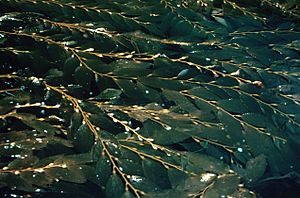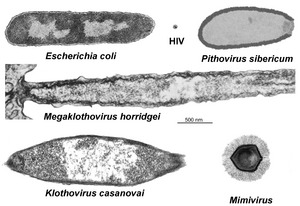Largest organisms facts for kids

Have you ever wondered what the biggest living things on Earth are? This article explores the largest organisms, from tiny bacteria to giant whales! We can measure size in different ways: how heavy something is (mass), how long it is (length), or how much space it covers (area).
Sometimes, many organisms live together, like a colony of ants or the Great Barrier Reef. But we're focusing on single, huge organisms here. For example, Pando, a huge group of aspen trees connected by their roots, is considered the heaviest single organism. And the blue whale is the biggest animal ever known!
Contents
Giant Plants: The Biggest Green Things
The largest single tree by wood volume and mass is the giant sequoia (Sequoiadendron giganteum). These amazing trees grow in California and can be as tall as a 20-story building and as wide as a small house!
Pando is a giant group of aspen trees in Utah. All these trees are actually one single organism, connected by their roots! It covers a huge area, like a forest that's all one plant.
The largest plant by area is a special seagrass called Posidonia australis found in Shark Bay, Australia. It stretches for about 180 kilometers (that's like driving for two hours!) and covers an area bigger than many cities. It is also one of the oldest living things on Earth! Another type of Posidonia seagrass found near Spain might be 100,000 years old, making it one of the oldest organisms in the world.
The biggest individual flower is the Rafflesia arnoldii, which smells like rotting meat! And the Amorphophallus titanum has the largest unbranched flower cluster, also known as the "corpse flower" because of its smell. Both are from Sumatra in Indonesia.
Green Algae: Simple but Big
Green algae are simple green plants. Some, like Acetabularia, can grow to be a few inches long, even though they are just one cell! Another type, Caulerpa taxifolia, can grow up to a foot long.
Amazing Animals: Giants of the Earth
The biggest animals are all marine mammals, especially whales. The blue whale is thought to be the largest animal that has ever lived on Earth. It is longer than three school buses!
On land, the largest animal is the African bush elephant.
Fungi: The Hidden Giants
The largest living fungus might be a honey fungus called Armillaria ostoyae. A huge colony of this mushroom was found in Oregon, USA. It covers an area of about 8.9 square kilometers (that's bigger than many towns!) and might weigh as much as 35,000 tons. This fungus is estimated to be 2,400 years old.
Even though the Armillaria ostoyae colony is huge, its individual mushrooms are quite small, only a few inches across. The largest single mushroom (the fruiting body) ever found was a Phellinus ellipsoideus from Hainan Island. It weighed about 500 kilograms (that's like a small car!).
Lichens: A Partnership of Giants
Umbilicaria mammulata is one of the largest lichens in the world. Its main body can be up to 15 centimeters wide, but some have been found that are over 60 centimeters wide! The longest lichen is Usnea longissima, which can grow to be more than 20 feet long.
Protists: The Microscopic Giants

Protists are a very diverse group of organisms, many of which are single-celled.
Amoebozoans: Blob-like Giants
Among single-celled organisms, some of the largest are slime molds, like Physarum polycephalum. These can grow to be over 12 inches wide! Even though they are one cell, they have many nuclei inside.
Rhizarians: Amoeba-like Giants
Some of the largest amoeboids are foraminiferans. One species, Syringammina fragilissima, can grow to be 20 centimeters (about 8 inches) in size!
Stramenopiles: The Giant Kelp
The largest stramenopiles are giant kelp from the Pacific Ocean. The floating stem of Macrocystis pyrifera can grow to be over 45 meters (about 150 feet) tall. This makes it the largest brown alga, the largest chromist, and generally the largest protist.
Bacteria: Tiny but Mighty Giants
The largest known species of bacterium is Thiomargarita magnifica. It can grow up to 1 centimeter long, which is huge for a bacterium! It's about five thousand times bigger than most bacteria and can be seen without a microscope. It looks like a human eyelash.
- Cyanobacteria
One of the largest "blue green algae" is Lyngbya. Its cells can be 50 micrometers wide.
Viruses: The Smallest Giants
The largest virus ever found is wikispecies:Megaklothovirus horridgei. It is 4 micrometers long, which is similar in size to a typical bacterium and big enough to be seen with a light microscope. It was discovered in 2018 and infects arrow worms. Before this, the largest viruses were from the genus Pandoravirus, which are about 1 micrometer in size and infect amoebas.
Images for kids
See also
- Charismatic megafauna
- Deep-sea gigantism
- Genome size
- Island gigantism
- Largest body part
- Largest prehistoric animals
- List of longest-living organisms
- List of heaviest land mammals
- List of world records held by plants
- List of largest inflorescences
- Lists of organisms by population
- List of longest vines
- Megafauna
- Smallest organisms
- Superorganism





